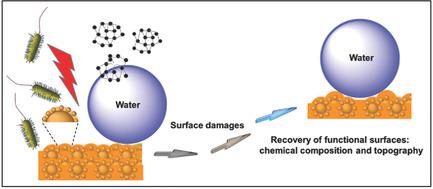当前位置:
X-MOL 学术
›
Adv. Mater. Interfaces
›
论文详情
Our official English website, www.x-mol.net, welcomes your feedback! (Note: you will need to create a separate account there.)
Self‐Healing Functional Surfaces
Advanced Materials Interfaces ( IF 5.4 ) Pub Date : 2018-07-02 , DOI: 10.1002/admi.201800293 Catarina Esteves 1
Advanced Materials Interfaces ( IF 5.4 ) Pub Date : 2018-07-02 , DOI: 10.1002/admi.201800293 Catarina Esteves 1
Affiliation

|
During the last decade extensive research has focused on designing functional surfaces, e.g., with self‐cleaning, antibacterial, or antifouling properties, driven by the industrial demand on innovation and sustainability, and the academic interest in new functional materials. Such functionalities are strongly related with surface characteristics, namely chemical composition, physical properties, and topography. Surfaces are, however, dynamic and easily damaged resulting in reduced performance or immediate loss of the functionality. Damage is ubiquitous, hence incorporating self‐healing mechanisms allows repairing the functionalities while maintaining a high performance with extended service lifetime. Polymeric surfaces are particularly relevant for functional materials, covering the large majority of devices that are currently used. However, due to their chemical nature, they are typically soft and vulnerable to damages. This report covers the most recent advances concerning self‐healing functional surfaces. Low adherence polymeric surfaces are addressed. Further then recovering chemical composition only, additional challenges raised by the recovery of other surface features, such as roughness, porosity, or heterogeneity, are considered. The impact of inherent surface dynamics on the recovery of surface functionalities is discussed, the limitations are highlighted and alternatives are suggested. The recent progress on self‐healing of reversible and responsive surfaces is addressed and future research directions for self‐healing functional surfaces are anticipated.
中文翻译:

自修复功能面
在过去的十年中,受到工业对创新和可持续性的需求以及对新型功能材料的学术兴趣的驱使,广泛的研究集中于设计具有自洁,抗菌或防污性能的功能性表面。这些功能与表面特征,即化学组成,物理性质和形貌密切相关。但是,表面是动态的,容易损坏,从而导致性能降低或功能立即丧失。损坏无处不在,因此结合了自我修复机制可以修复功能,同时保持高性能并延长使用寿命。聚合物表面与功能材料特别相关,涵盖了当前使用的大多数设备。然而,由于其化学性质,它们通常是柔软的,容易损坏。本报告涵盖了有关自修复功能性表面的最新进展。解决了低粘附力的聚合物表面。然后仅恢复化学组成,还要考虑由于恢复其他表面特征(例如粗糙度,孔隙率或异质性)而引起的其他挑战。讨论了固有的表面动力学对表面功能恢复的影响,强调了局限性并提出了替代方案。讨论了可逆和响应表面自修复的最新进展,并展望了自修复功能表面的未来研究方向。本报告涵盖了有关自修复功能性表面的最新进展。解决了低粘附力的聚合物表面。然后仅恢复化学组成,还要考虑由于恢复其他表面特征(例如粗糙度,孔隙率或异质性)而引起的其他挑战。讨论了固有的表面动力学对表面功能恢复的影响,强调了局限性并提出了替代方案。讨论了可逆和响应表面自修复的最新进展,并展望了自修复功能表面的未来研究方向。本报告涵盖了有关自修复功能性表面的最新进展。解决了低粘附力的聚合物表面。然后仅恢复化学组成,还要考虑由于恢复其他表面特征(例如粗糙度,孔隙率或异质性)而引起的其他挑战。讨论了固有的表面动力学对表面功能恢复的影响,强调了局限性并提出了替代方案。讨论了可逆和响应表面自修复的最新进展,并展望了自修复功能表面的未来研究方向。考虑了其他表面特征(例如粗糙度,孔隙率或异质性)的恢复所带来的其他挑战。讨论了固有的表面动力学对表面功能恢复的影响,强调了局限性并提出了替代方案。讨论了可逆和响应表面自修复的最新进展,并展望了自修复功能表面的未来研究方向。考虑了其他表面特征(例如粗糙度,孔隙率或异质性)的恢复所带来的其他挑战。讨论了固有的表面动力学对表面功能恢复的影响,强调了局限性并提出了替代方案。讨论了可逆和响应表面自修复的最新进展,并展望了自修复功能表面的未来研究方向。
更新日期:2018-07-02
中文翻译:

自修复功能面
在过去的十年中,受到工业对创新和可持续性的需求以及对新型功能材料的学术兴趣的驱使,广泛的研究集中于设计具有自洁,抗菌或防污性能的功能性表面。这些功能与表面特征,即化学组成,物理性质和形貌密切相关。但是,表面是动态的,容易损坏,从而导致性能降低或功能立即丧失。损坏无处不在,因此结合了自我修复机制可以修复功能,同时保持高性能并延长使用寿命。聚合物表面与功能材料特别相关,涵盖了当前使用的大多数设备。然而,由于其化学性质,它们通常是柔软的,容易损坏。本报告涵盖了有关自修复功能性表面的最新进展。解决了低粘附力的聚合物表面。然后仅恢复化学组成,还要考虑由于恢复其他表面特征(例如粗糙度,孔隙率或异质性)而引起的其他挑战。讨论了固有的表面动力学对表面功能恢复的影响,强调了局限性并提出了替代方案。讨论了可逆和响应表面自修复的最新进展,并展望了自修复功能表面的未来研究方向。本报告涵盖了有关自修复功能性表面的最新进展。解决了低粘附力的聚合物表面。然后仅恢复化学组成,还要考虑由于恢复其他表面特征(例如粗糙度,孔隙率或异质性)而引起的其他挑战。讨论了固有的表面动力学对表面功能恢复的影响,强调了局限性并提出了替代方案。讨论了可逆和响应表面自修复的最新进展,并展望了自修复功能表面的未来研究方向。本报告涵盖了有关自修复功能性表面的最新进展。解决了低粘附力的聚合物表面。然后仅恢复化学组成,还要考虑由于恢复其他表面特征(例如粗糙度,孔隙率或异质性)而引起的其他挑战。讨论了固有的表面动力学对表面功能恢复的影响,强调了局限性并提出了替代方案。讨论了可逆和响应表面自修复的最新进展,并展望了自修复功能表面的未来研究方向。考虑了其他表面特征(例如粗糙度,孔隙率或异质性)的恢复所带来的其他挑战。讨论了固有的表面动力学对表面功能恢复的影响,强调了局限性并提出了替代方案。讨论了可逆和响应表面自修复的最新进展,并展望了自修复功能表面的未来研究方向。考虑了其他表面特征(例如粗糙度,孔隙率或异质性)的恢复所带来的其他挑战。讨论了固有的表面动力学对表面功能恢复的影响,强调了局限性并提出了替代方案。讨论了可逆和响应表面自修复的最新进展,并展望了自修复功能表面的未来研究方向。



























 京公网安备 11010802027423号
京公网安备 11010802027423号